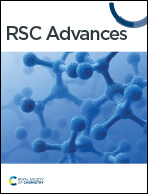Advancements in sustainable platinum and palladium recovery: unveiling superior adsorption efficiency and selectivity with a novel silica-anchored acylthiourea adsorbent†
Abstract
This study addresses the pressing issue of depleting natural resources of platinum group metals (PGMs), driven by their widespread use in modern applications and increasing demand for renewable energy technologies. With conventional sources dwindling, the search for economically viable recovery methods from alternative sources has become crucial. Our focus was on innovating efficient recovery strategies, leading to the development of two novel silica-anchored adsorbents: DTMSP-BT-SG, a highly efficient acylthiourea adsorbent, and BTMSPA-SG, a silica-anchored amine adsorbent. We conducted comprehensive experiments under PGM mining wastewater conditions, varying parameters such as adsorbent mass, pH, concentration, contact time, competing ions, and volume. DTMSP-BT-SG demonstrated exceptional performance, achieving maximum adsorption efficiencies of >98% for Pt and >99% for Pd at pH 2, 0.5 g L−1 dosage, and 5 mg L−1 concentration. In contrast, under the same conditions, BTMSPA-SG recovered <56% and <89% of Pt and Pd, respectively. The experimental data for both adsorbents were analysed using Langmuir and Freundlich isotherm models for concentration and pseudo-first and second-order models for contact time. The Langmuir model best described the adsorption data, indicating homogenous monolayer adsorption of Pt and Pd. The kinetic models suggested a pseudo-second-order process, implying chemisorption. Furthermore, in the presence of competing ions and other PGMs, DTMSP-BT-SG exhibited significantly higher recovery rates for Pt and Pd compared to BTMSPA-SG. Overall, DTMSP-BT-SG emerged as a more selective and efficient adsorbent across varied parameters. Its exceptional adsorption efficiency, coupled with cost-effectiveness, positions it as a promising and competitive recovery agent for extracting PGMs from mining wastewaters.



 Please wait while we load your content...
Please wait while we load your content...